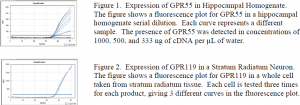Ryan Williamson and Dr. Jeff Edwards, Department of Physiology and Developmental Biology
The hippocampus is the part of the brain that mediates learning and memory by altering the function of synapses within its circuitry via intracellular signaling molecules. The ability of synapses to change is called synaptic plasticity. Hippocampal synaptic plasticity can be mediated by endogenous lipid-based signaling molecules called endocannabinoids (eCBs) [3]. Two of the best studied eCBs are anandamide (AEA) and 2-arachidonoyl glycerol (2-AG). Physiology data suggests that AEA may mediate synaptic plasticity in neurons of the stratum radiatum region of the hippocampus by binding to an unclassified G protein-coupled receptor called GPR55 [2,3,4,5]. Additionally, another unclassified G-protein coupled receptor, GPR119, has been shown to bind to a metabolite of anandamide [2,3]. The goal of my project is to determine GPR55 and GPR119 expression among various hippocampal cell types. Our hypothesis is that GPR55 and GPR119 mRNA will be found in hippocampal CA3 neurons but not in stratum radiatum neurons.
We used quantitative polymerase chain reaction (qPCR) to measure relative expression levels of various cDNA products. To do this we added a short probe that bound to the DNA template of interest [6]. Each time a template molecule was replicated, one probe molecule fluoresced. We quantified the amount of GPR55 and GPR119 cDNA by measuring fluorescence of samples during the amplification process. We also measured the expression of several cDNA products that are differentially expressed among neuron types. Additionally, we measured expression of 18S ribosomal RNA, which was used to normalize fluorescence values in each cell [1]. We compared variation in product quantity from one cell to another by taking the difference between the inflection points of the fluorescence curves for each cell. Using this information, we have begun to characterize expression of GPR55 and GPR119 in stratum radiatum neurons.
The results of preliminary experiments we have conducted so far indicate that GPR55 and GPR119 are expressed in hippocampal tissue. In these preliminary experiments, we homogenized rat hippocampi and performed qPCR using GPR55 and GPR119 primers and probes on cDNA created from isolated mRNA. In these experiments, we found that GPR119 mRNA was detected in hippocampal homogenate templates of 10 ng cDNA concentration per μL of water and higher. GPR55 was only detected in hippocampal homogenate of at least 333 ng/μL cDNA (see Figure 1). This suggests that GPR55 may only be found in small quantities in hippocampal tissue.
We also performed several whole cell qPCR experiments on stratum radiatum neurons. Out of the 10 cells that have been quantified so far, none expressed GPR55 mRNA and 3 cells expressed GPR119 mRNA (see Figure 2). The findings for GPR55 agree with our hypothesis and with previous physiology data which suggests the presence of AEA-activated receptors on CA3 but not stratum radiatum neurons. The results for GPR119 do not agree with our hypothesis and suggest that GPR119 may play an unknown role in modulating the activity of
stratum radiatum neurons. However, these results are preliminary and more experiments will take place to provide more conclusive results.
Currently, we are working on collecting more data from neurons of the stratum radiatum. We hope to finish collecting this data by the end of winter semester and begin collecting data for CA3 neurons. We expect that GPR55 will remain undetected in stratum radiatum neurons, but that it will be expressed in some CA3 neurons. The data we obtained showing GPR119 expression in stratum radiatum neurons suggests that the receptor may not follow the expression patterns observed in other cannabinoid receptors. Hippocampal homogenate experiments suggest that GPR119 is expressed at high levels in hippocampal tissue. Therefore, it is possible that GPR119 is expressed in both CA3 and stratum radiatum neurons. Further experiments will clarify the expression patterns of GPR119.
We expect this project to be completed by the beginning of summer term. Results from this project will identify the expression of GPR55 and GPR119 and provide a foundation of knowledge for future study of the role these receptors play in modulating the activity of neurons of the hippocampus.
Acknowledgements
I thank Dr. Jeff Edwards for providing materials and equipment and for his invaluable feedback. I also thank Collin Merrill for instruction on qPCR and whole cell patch clamp techniques.

References
- Abush H, Akirav I: Cannabinoids modulate hippocampal memory and plasticity.Hippocampus 2009.
- Begg M, Pacher P, Bátkai S, Osei-Hyiaman D, Offertáler L, Mo F-M, Liu J, and Kunos G Evidence for novel cannabinoid receptors. Pharmacol Ther 106:133-145, 2005.
- Brown AJ. Novel cannabinoid receptors. Br J Pharmacol 152: 567–575, 2007.
- Edwards J, Gibson H, Jensen T, Nugent F, Walther C, Blickenstaff J, Kauer J. A novel non-CB1/TRPV1 endocannabinoid-mediated mechanism depresses excitatory synapses on hippocampal CA1 interneurons. Hippocampus
- Ryberg E, Larsson N, Sjogren S, Hjorth S, Hermansson N, Leonova J, Elebring T, Nilsson K, Drmota T, Greasley P. The orphan receptor GPR55 is a novel cannabinoid receptor. Br J Pharmacol 152: 1092–1101, 2007.
- Weng J, Lin Y, Lien C. Cell type-specific expression of acid-sensing ion channels in hippocampal interneurons. J Neurosci 30: 6548–6558, 2010.
